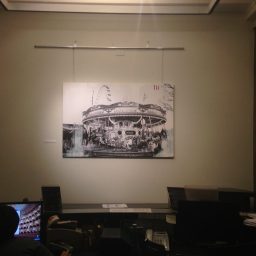The Sala Umberto theatre, projected by Arch. Andrea Busiri Vici decorated by the renown Alessandro Bazzani, inaugurates in 1882 the concert hall he names Theatre of the Piccola Borsa.
In 1890 comes the Arch’s intervention. Giulio Podesti enlarges the capacity of the hall to 650 seats, and around 1900 it is renamed with its current name. In 1906 it is used as a Cinemofono. After Petrolini’s debut on the 25th of May 1911, a series of adjustments were operated on the hall by Attilio Spaccarelli and Arnaldo Foschini, for the occasion of the Universal Exhibition for the 50 years from the Italian Unification. In 1928 further changes were made on the hall, which had a large stage with a 12 metres long proscenium and modern installations for the projection of films.
It is historically recognized as the Temple of Truth and of the Italian Magazine between the years 1910s and 1940s. On its stage act Ettore Petrolini, Raffaele Viviani, Nicola Maldacea, Toto, Aldo Fabrizi, the De Filippo brothers, Anna Fougez, Odoardo Spadaro, the De Rege brothers, Lydia Johnson, Riviera Five, Renato Rascel, Rossano Brazi, the three Bonos brothers, Cuttica, Alfredo Bambi, the De Vico brothers, Michele Galdieri, the Isa Lysette company, Libero Bovio, Anna Magnani, and Walter Chiari. In the fifties, sixties, and seventies, the Sala Umberto is used for filmic purposes. In 1980 it is wholly renovated, and in 1981 it becomes a theatre again. The first season is directed by Luigi Longobardi and inaugurated by the great Domenico Modugno in Luigi Antonelli’s The Man who Found Himself (L’uomo che incontrò se stesso), directed by Enzo Fenoglio. From 1983 to 1991 the artistic schedule is directed by ETI (Ente Teatrale Italiano), guided by widely esteemed Bruno D’Alessandro. From 1991 to 2001 the hall goes back to being devoted to cinema, under the hand of the Istituto Luce and then Medusa.
In September 2002, after a further renovation, it picks up its theatrical activities under the artistic direction of Alessandro Longobardi, whom inaugurates the season with the Maddalena Crippa show Femmine Fatali, created and directed by Peter Stain, giving prose seasons parallel initiatives amongst which: the opening of an intense educational series of activities with the Teatro Ragazzi (Theatre for Children), directed by Livia Clementi, a number of cultural projects that range from contemporary theatre to dance, from recitals to concerts, and the opening of the Vivistrot, a space reserved to restaurants.
In 2004 the foyer was renovated as a space for hosting exhibitions: ‘Spazio Arte Sala Umberto’ (‘Sala Umberto Art Space’), an ideal location for both exhibitions and artistic performances.
Events at Rome Art Week
2018
Free access
Free access







